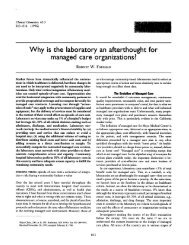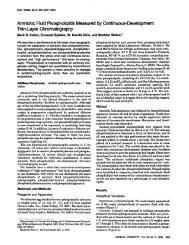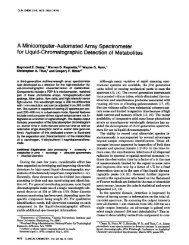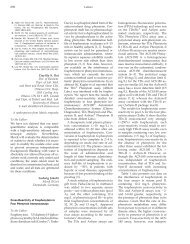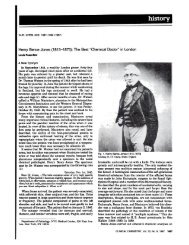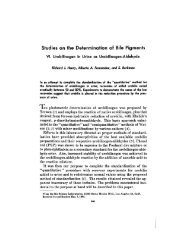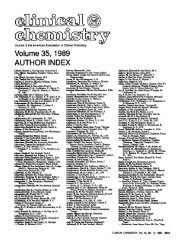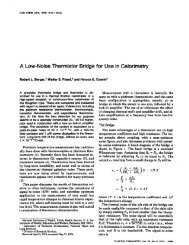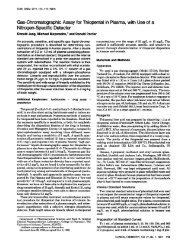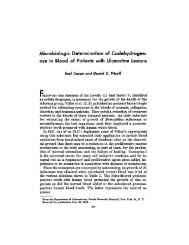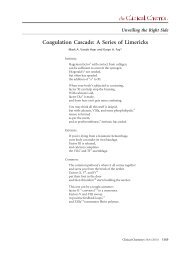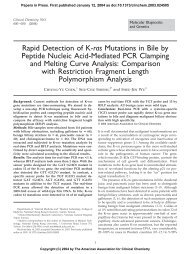Analytical Bias in a Quality Control Scheme - Clinical Chemistry
Analytical Bias in a Quality Control Scheme - Clinical Chemistry
Analytical Bias in a Quality Control Scheme - Clinical Chemistry
Create successful ePaper yourself
Turn your PDF publications into a flip-book with our unique Google optimized e-Paper software.
<strong>Analytical</strong> <strong>Bias</strong> <strong>in</strong> a <strong>Quality</strong> <strong>Control</strong> <strong>Scheme</strong><br />
John R. Allen,* Rachel Earp, E. Christis Farrell, Jr.,<br />
and H. D. GrUmer<br />
A quality control program utiliz<strong>in</strong>g both “known” and “bl<strong>in</strong>d” control specimens<br />
was analyzed <strong>in</strong> the rout<strong>in</strong>e cl<strong>in</strong>ical chemistry laboratory. The results obta<strong>in</strong>ed with<br />
the control samples of 18 automated and nonautomated procedures demonstrated<br />
the presenceof analytical bias. Only through the evaluation of bl<strong>in</strong>d control samples<br />
tested at random times can a reliable measure of the proficiency of the laboratory<br />
be achieved.<br />
‘THE CLINICAL CHEusmY Laboratories of The Ohio State University<br />
Hospitals perform approximately 500,000 analyses per year, <strong>in</strong>clud<strong>in</strong>g<br />
24,000 control specimens. A considerable number of these control specimens<br />
are sent through the laboratory as “bl<strong>in</strong>d” samples. When<br />
review<strong>in</strong>g our control data, we wondered whether a systematic difference<br />
appears between the data derived from known and unknown<br />
control samples. If no significant divergence between the 2 groups<br />
could be found <strong>in</strong> our laboratory, it would permit us to reduce the<br />
number of “bl<strong>in</strong>d” samples. When review<strong>in</strong>g the literature we found<br />
to our surprise only one reference deal<strong>in</strong>g with this subject matter <strong>in</strong><br />
a cl<strong>in</strong>ical laboratory, and this one reported tile absence of bias between<br />
known and unknown control results (i).<br />
The purpose of this h-t’portis to make available our data on known<br />
and unknown control samples and to report the presence of bias. In<br />
addition, we would like to present our standard deviations and coefficient<br />
of variation of a variety of tests from a s<strong>in</strong>gle identified source.<br />
From the Division of Cl<strong>in</strong>ical Cheuiiistu-y, Departmont of Pathology, The Ohio State Uni.<br />
versity, Columbus, Ohio 43210.<br />
Presented at the meet<strong>in</strong>g of the American Association of Cl<strong>in</strong>ical Chemists, Wash<strong>in</strong>gton,<br />
DC, August 1968.<br />
Thanks are due Dr. Ransom Whitney, Director of the Statistics Laboratory, and Dr. Mart<strong>in</strong><br />
Keller’s Biometric Group of tIn’ Department of Preventive Medic<strong>in</strong>e, The Ohio State<br />
U niversity.<br />
Received for publication %OV 29, 1968; accepted for publication July 15, 1969.<br />
Present address: Cl<strong>in</strong>ical <strong>Chemistry</strong> Section, Department of Pathology, Decatur Memorial<br />
hospital, 2300 N Edwod St, Decatur, Ill 62526. -<br />
1039
1040 ALLEN fT AL Cl<strong>in</strong>ical <strong>Chemistry</strong><br />
Methods<br />
The presently used quality control method was <strong>in</strong>stituted 2 years<br />
ago with assistance from The Ohio State I. lilversity Statistics l)ivisioii<br />
(2-4).<br />
<strong>Control</strong> samples analyzed <strong>in</strong> the laboratory are of three types. There<br />
are samples the technologist knows are controls: These are of pooled<br />
serum processed and stored frozen. After the test has beeii standardized,<br />
only the first daily result of the 1)001 for every constituent is<br />
used for statistical analysis. Tilell there are coni<strong>in</strong>erical control<br />
samples, used at the discretion of the technologist; these results are<br />
not kept on record. F<strong>in</strong>ally, there are control samples unknown to the<br />
technologist, consist<strong>in</strong>g of commercial control samples at two or three<br />
levels of concentration. Oniy the results of the control hav<strong>in</strong>g a concentration<br />
approximat<strong>in</strong>g that of the pool have been tabulated (Tables<br />
land 2).<br />
<strong>Control</strong> samples, not known as controls to tile technologist, were<br />
submitted at randoni times dur<strong>in</strong>g the work day with a sillluiated<br />
patient ielentilication. The time was determ<strong>in</strong>ed by a table of ratidom<br />
numbers. Results of the pool as well as the unknown commercial controls<br />
were plotted daily on conlputer-prepared control charts <strong>in</strong>dicat<strong>in</strong>g<br />
the mean and tile permissible deviation. Values outside the prescribed<br />
limits were brought to the attention of the supervisor. The limits used<br />
to evaluate daily performance were usually the 2 standard deviations<br />
calculated over a 3-month period. The number of analyses is about fit)<br />
for each test. No changes iii methodology occurred dur<strong>in</strong>g this -niontii<br />
period for any one test.<br />
Results<br />
Results of control analysis over a period of 6 months showed differences<br />
between sonic of tile known and unknown controls (Tal)le 1).<br />
rflle mean values of the known calcium pool and tile bl<strong>in</strong>d control for<br />
calcium, for <strong>in</strong>stance,differ by about 1% while the standard deviation<br />
differsby a factor of about 2.<br />
1xanumation of time results of 18 tests <strong>in</strong> Table 1 shows that the<br />
known control samples for 16 of the 18 tests had a smaller standard<br />
deviation and 15 of tile 18 tests had a smaller coefficient of variation<br />
than the unknown controls. The prohalility of this occurr<strong>in</strong>g by cilance<br />
alone is less than 0.001 for the standard deviation and less than 0.01<br />
for the coefficient of variation <strong>in</strong> a one-tailed test. S<strong>in</strong>ce the data did<br />
not follow a parametric or normal distribution, a nonparametric statistical<br />
analysis, that is, a b<strong>in</strong>omial distribution, was employed for the<br />
calculations.
Vol. 15, No. II. 1969 ANALYTICAL BIAS 1041<br />
Table 1. ItEsuhis wirti BLIND (\ERsroI.) ANn KNOWN (Pool.) C sraoi.s .r<br />
Onio STATE UNIVERSITY HOSPITALS, 0’T. 1967-MARcH 1968<br />
Specimen .Wean<br />
Versatol<br />
SI) CV .Vo. Mean<br />
Pool<br />
SD CV No.<br />
Album<strong>in</strong> 3.4 0.16 2.9 127 4.3 0.13 3.0 133<br />
Calcium 4.8 0.10 40 127 4.2 0.09 2.2 164<br />
Chb)ridet 102 1 .6 1 .6 127 104 0.8 0.8 182<br />
Creatituiuuet 1.7 0.11 6.3 123 1.9 0.08 4.4 183<br />
(iIobiJ<strong>in</strong> 2.2 0.12 5.7 129 2.6 0.13 5.6 137<br />
(;lucoset 82 :1.4 4.2 126 116 2.7 2.3 183<br />
r.P. 4.3 0.30 6.7 125 4.0 0.21) 4.9 126<br />
Kt 3.0 0.13 3.0 126 4.7 0.12 2.5 183<br />
Nat 140 2.4 1.7 127 143 1.2 0.8 l83<br />
Tot, prote<strong>in</strong> 7.6 0.19 2.5 12$ 73) 0.17 2.4 136<br />
Urea-Nt 12.5 0.8 6.6 125 25.2 0.8 3.0 183<br />
Uric Acidt 3.9 0.27 4.5 173 5.6 0.22 4.0 182<br />
Cholesterol 224 13 6.5 127 200 7.0 :1.3 124<br />
Alk. p’tase 6.9 0.4:1 6.2 126 2.6 0.15 3.6 127<br />
Amylase 230 17 6.9 127 103 10 9.7 173<br />
LDH 303 52 10.4 12(1 261 24 9.3 131<br />
SOOT 133 12 9.3 121 23.7 3.2 13 129<br />
SGPT 10.7 3.0 28 111 18.9 3.1 16 121<br />
* Ntunber of analyses for each constituent is equal to the number of days on which the given<br />
procedure ha.s beemi reported.<br />
f Automated procedures.<br />
Exam<strong>in</strong>ation of each of the seven automated tests shows that the<br />
average of the monthly standard deviations and of the monthly coefficients<br />
of variation of the unknown control samples was greater<br />
than the known samples <strong>in</strong> all cases (7+). The probability of this<br />
occurr<strong>in</strong>g by chance is less than 0.01.<br />
Of the 11 nonautomated tests, tile standard deviation of tile unknown<br />
controls was greater than that of known controls <strong>in</strong> 9 <strong>in</strong>stances, and<br />
tue coefficient of variation was greater <strong>in</strong> eight tests. The probability<br />
of this occurr<strong>in</strong>g by chance is 0.027 for the standard deviation arid<br />
0.081 for the coefficient of variation.<br />
Discussion<br />
The data <strong>in</strong> Table 1 illustrate tile variation between “known” controls<br />
and ‘‘bl<strong>in</strong>d’’ controls <strong>in</strong> several rout<strong>in</strong>e cl<strong>in</strong>ical chemistry tests.<br />
The “bl<strong>in</strong>d” sample, more like that of a patient’s specimen, measures<br />
Ilie precision actually achieved Ill the laboratory, <strong>in</strong> contrast to<br />
“known’’ controls which measure tile precision the laboratory is<br />
capable of achiev<strong>in</strong>g. It should 1)e emphasized that these data were<br />
collected by do<strong>in</strong>g just one set of control samples a day, and except<br />
for the known control samples chosen by the technologist for check<strong>in</strong>g
1042 ALLEN fT AL Cl<strong>in</strong>ical <strong>Chemistry</strong><br />
himself, he was not aware that lie was us<strong>in</strong>g a control sample until<br />
after the work was completed.<br />
Table 2 presents the coefficient of variation of’ some constituents<br />
that appear on Table 1 with those data reported by Straumfjord and<br />
Copeland (5). These authors made no mention as to whether their data<br />
were derived from known or unknown samples or a comb<strong>in</strong>ation<br />
thereof. Thus, for <strong>in</strong>stance, we might have a problem with our manual<br />
phosphorus procedure if Straumfjord and Copeland’s data (5) are<br />
derived from unknown samples. The calcium shows a difference between<br />
the known and the unknown specimen; the known value compares<br />
favoi’ably with the coefficient of variation of these authors. The<br />
amylase results are contrary to what we expect with regard to coefficient<br />
of variation of the known and bl<strong>in</strong>d specimens, and are probably due<br />
to the higher mean of the unknown sample (250 versus l0 Somogyi<br />
units for the known sample).<br />
For the rema<strong>in</strong>der of the procedures our coefficient of variation for<br />
the known samples is <strong>in</strong> the same range as those reported by<br />
Straumfjord and Copeland. Although the occurrence of bias <strong>in</strong> the<br />
imonautomated tecl<strong>in</strong>ics group, as a whole, was not significant at the 5%<br />
level, this does not exclude the possibility that bias may occur <strong>in</strong> any<br />
one method. The ease with which a b<strong>in</strong>omial sign test can be carried<br />
out recommends this method as a useful tool for recogniz<strong>in</strong>g differences<br />
<strong>in</strong> handl<strong>in</strong>g of control samples <strong>in</strong> a group of procedures.<br />
S<strong>in</strong>ce we are also report<strong>in</strong>g the presence of bias <strong>in</strong> fully automated<br />
tests, where, at least <strong>in</strong> theory, bias should be negligible, one wonders<br />
how this bias is <strong>in</strong>troduced. Instrumental <strong>in</strong>exactness of the sampler<br />
phas<strong>in</strong>g <strong>in</strong> the AutoAnalyzer system has been reported (6, 7). If known<br />
control samples are <strong>in</strong>troduced directly after the standards, as <strong>in</strong> our<br />
case, arid only then reported by the medical technologist after he has<br />
Table 2. CoMPARISON OF COEFFICIENT OF \ARIATION:<br />
OHIO STATE U NIVERSITY IIosPcrus<br />
(OcT 1967-MARCH 1968) AND STRAUMFJO RI) & Cul’EJ.AND<br />
Specimen<br />
O.S.U.I!. Slraumfjord&<br />
uaknown - Copeland<br />
Cholesterol 6.5 .5. 1 3.5<br />
Alkal<strong>in</strong>e p’tase 6.2 10.6 5.6<br />
Amylase<br />
6.9 8.1<br />
9.7<br />
Calcium<br />
4.0 2.3<br />
2.2<br />
Chloride’<br />
1.6 1.0<br />
0.8<br />
Glucose<br />
4.2 3.1<br />
2.3<br />
I.P.<br />
6.7 4.9<br />
49<br />
Potassium 3.0 2.5 2.5<br />
Sodium 1.7 1.1 - 0.8<br />
().S.U.II.<br />
known
Vol. 15, No. II, 1969 ANALYTICAL BIAS 1043<br />
conv<strong>in</strong>ced himself of <strong>in</strong>itialsatisfactoryperformance of the procedure,<br />
these samples failto unmask <strong>in</strong>strument driftsand specimen <strong>in</strong>teraction<br />
(8). Amenta (8) also reported twofold differences <strong>in</strong> standard errors<br />
between samples which <strong>in</strong> each run were placed <strong>in</strong> the same position,<br />
usually directly after tile standard and duplicate samples which were<br />
placed at random. It is generally acknowledged that drifts occur, as<br />
evidenced by shifts of known control results. Unfortunately, under the<br />
pressure of daily rout<strong>in</strong>e and the boredom of read<strong>in</strong>g peak after peak<br />
from the recorder, it is virtually impossible to correct for drifts unless<br />
the error becomes of such magnitude that the elim<strong>in</strong>ation of the<br />
underly<strong>in</strong>g malfunction becomes mandatory, or if the error is of lesser<br />
magnitude, it call be compensated, for <strong>in</strong>stance, with a computer-aided<br />
program. We feel that, at least ill part, a similar situation can occur<br />
for automated procedures as that described for manual technics by<br />
Rob<strong>in</strong>son (9).<br />
Addendum<br />
The methods used <strong>in</strong> this laboratory and listed <strong>in</strong> Table 1 are<br />
itemized below. Some modifications have been made <strong>in</strong> some of the<br />
technics; therefore, reference to the orig<strong>in</strong>al literature only implies<br />
the underly<strong>in</strong>g pr<strong>in</strong>ciple of the technic used.<br />
Album<strong>in</strong> K<strong>in</strong>gsley, C. B., J, Biol. Cheni. 133, 731 (1940).<br />
I1ove, P. E., J. Biol, Chem. 49, 109 (1921) ; 57, 235 (1923).<br />
Calcium Dielul, H., and Ell<strong>in</strong>gboe, J. L., Anal. Chem. 28, 811 (1946).<br />
Schwarzenbach, C., Helu. C/jim. Acta 29, 811 (1946) ; 30, 1798 (1947)<br />
32, 1314 (1949); 37, 113 (1954).<br />
Chloride AutoAnalyzer modification (N-5a) of the method of Zall, D. M., Fisher, 1).,<br />
:uuid Garner, M. 0., Anal. Chenu. 28, 1665 (1956).<br />
Creat<strong>in</strong><strong>in</strong>e AutoAnalyzer modification (N-ha) of the method of Fol<strong>in</strong> and Wu, taken<br />
fu-oun Hawk, Oser, and Sumnmerson, Practical Ph ysiological <strong>Chemistry</strong><br />
(ed. 12). Blakistone, p 506.<br />
Globul<strong>in</strong> Same as album<strong>in</strong>.<br />
Glucose AutoAnalyzer modification (N-2a) of the method of Hoffman, W. S., J.<br />
Biol. Chem. 120, 51 (1937).<br />
1.1’, Shuiuiow:uu-a, C., Jones, L., ajud Re<strong>in</strong>luart, 11., .1. L’iol. Chum. 142, 921 (1942).<br />
K and Na Auto,\uialyzer technic N-20a, Technicon Coup, Ardsley, NY.<br />
Prote<strong>in</strong> Iliuret reaction, total prote<strong>in</strong> and album<strong>in</strong> ; Gornall, A. C., Bardewell, C. J.,<br />
and 1)avid, M. M., J. Biol, Chem. 177, 751 (1949).<br />
(le Ia Huerga, J., Smatten, G. W., and Sherrick, J. C., Assoc. Cl<strong>in</strong>. Scientists<br />
App1. Sem<strong>in</strong>ar on Prote<strong>in</strong>s, Oct 1963, Washiiiigtouu, DC.<br />
Urea-N - AutoAnalyzer method for the determ<strong>in</strong>ation of urea nitrogen <strong>in</strong> serum<br />
(N-la), Skeggs, L. T., Am. J. Cl<strong>in</strong>. Path. 28, 311 (1957).<br />
Marsh, W. H., F<strong>in</strong>gerhut, B., and Kirsch, B., Amer. J. Cl<strong>in</strong>. Path. 28, 681<br />
(1957).<br />
Uric acid - AutoAnalyzer method N-13a. Technicout Corp, Ardsley, NY.<br />
Cholesterol Leffler, H. H., l<strong>in</strong>er. J. Cl<strong>in</strong>. Path. 31, 310 (1959).<br />
Ziathis, A., Zak, B., and Boyle, A. J., J. Lab. CUn. Med. 41, 486 (1953).
1044 ALLEN FT AL Cl<strong>in</strong>ical <strong>Chemistry</strong><br />
Alk. phosphatase hiabson, A. L., Guculey, S. .T., Coleman, C. M.,.utiul I’luihipps, C. B., Cl<strong>in</strong>.<br />
(‘hem. 12, 484 (1966).<br />
Amylase Somogyi, 0., J. Biol. Che<strong>in</strong>. 125, 399 (1938).<br />
henry, B. ,I.,Cl<strong>in</strong>ical <strong>Chemistry</strong>, Pr<strong>in</strong>ciples and Technics, hloeber, New<br />
York, 1964, p. 471.<br />
LDH ltergmeyer, II. U., Methods of Enzymatic Analysis. Acad Press, New York,<br />
1963, p. 738.<br />
LDH Wr#{243}hheski,F., and LaDue, J. S., Proc. Soc. Exp. Thai. Med. 90, 210 (1955).<br />
GOT . GPT Karmen,<br />
(1955).<br />
A., WrThleski, F., and LaDue, J. S., J. Cl<strong>in</strong>. Invest. 34, 126<br />
Karmeuu, A., .1. Cliv. Invest. 34, 131 (1955).<br />
Gilford record<strong>in</strong>g spectropliotometer with automatic cuvet positioner and<br />
constant temperature at 25#{176} (±0.5n).<br />
Labeled values of control serum prepared by Warner-Cliilcott Laboratories:<br />
calcium, 5.1 mEq/L; chloride, 101.3 mEq/L; creatiri<strong>in</strong>e, 1.6<br />
mg/100 ml; glucose, 85 mg/100 ml; <strong>in</strong>organic phosphorus, 4.0 mg/<br />
100 ml; potassium, 4.9 mEq/L; sodium, 140 mEq/L; total prote<strong>in</strong>,<br />
7.0 g/100 ml; urea nitrogen <strong>in</strong> serum, 12.1 mg/100 ml; uric acid, 6.2<br />
mg/100 ml; cholesterol, 205 mg/100 ml; alkal<strong>in</strong>e phosphatase, 66 TJ or<br />
6.6 OSU-units; amylase, 262 Somogyi units: labeled value for LDII,<br />
not available <strong>in</strong> Wr#{243}hleskiunits; SGOT, 157 Karmen units: 110 data<br />
given for SGPT.<br />
References<br />
1. We<strong>in</strong>berg, M. S., auni Tlau-uiett, 11. N., Absence of analytical bias <strong>in</strong> a c<strong>in</strong>ahity control<br />
program. Amer. ,I. Cliv. Path. 38, 468 (1962).<br />
2. Tonks, D. B., A study of the accuracy and precision of ch<strong>in</strong>ienl chemistry dete,-uuuiii:utioius<br />
iii 170 Canadian laboratories. Cliv. Chem. 9, 217 (1963).<br />
3. Sax, S. M., Dor<strong>in</strong>an, L., Lihensen, 1). 1)., and Moore, J. J., Design and operation of an<br />
expanded system of quality couitrol. Cli,u. Chem, 13, 825 (1967).<br />
4. Conn, B. B., Jr., Best, M. L., Anido, V., and Cram, F. D., Computer analysis of quality<br />
control data. Bnii. Req. Med. Technol. 37, 243 (1967).<br />
5. Straumfjord, .1. V., .Jr., and Copeland, B. B., Cl<strong>in</strong>ical chemistry quality control values <strong>in</strong><br />
thirty-three university medical school hospitals. Amer. J. Cliii. Path. 44, 252 (1965’).<br />
(1. Thiers, B. B., Cole, B. B., and Kirsch, W. J., K<strong>in</strong>etic parameters of cont<strong>in</strong>uous f<strong>in</strong>nanalysis.<br />
Cl<strong>in</strong>. Chem. 13, 451 (1967).<br />
7. Young, D. S., Montague, B. M., and Snider, B. B., Studies of sampl<strong>in</strong>g tiunes <strong>in</strong> a<br />
cont<strong>in</strong>uous flow analytic system. Cliii. Chenu. 14, 993 (1968).<br />
8. Amenta, J. S., Analysis of variance, control charts, and the cl<strong>in</strong>ical laboratory. Anuer, ,J.<br />
Cl<strong>in</strong>. Path. 49, 842 (1968).<br />
9. Rob<strong>in</strong>son, R., Tedium and the law of d<strong>in</strong>uimuish<strong>in</strong>greturns <strong>in</strong> cl<strong>in</strong>ical biochemistry hiul,ou;utories.ASCP<br />
Snvu?ulary Report, June 1967.




